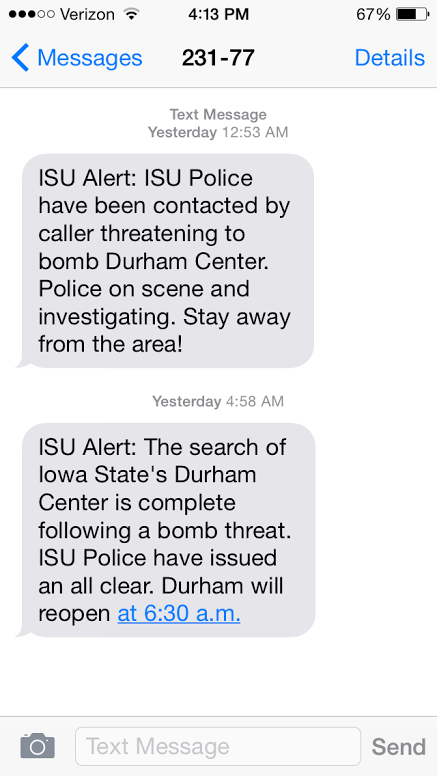Editorial: ISU alert spot on in recent event
Editorial: ISU Alert
April 28, 2015
The ISU and Ames Police Departments were called to the Durham Center Sunday evening after receiving a bomb threat over the phone from an unidentified person. After nearly six hours of trying to figure out what was going on, police left the Durham Center, fortunately, empty handed. The call came in around 12:30 a.m. and at 12:52 and 12:53 a.m., ISU students’ emails and phones began to receive an ISU Alert about the possible bomb threat.
Rewind to November 2013, police pursued a dangerous driver onto Central Campus, ending with shots fired by police and the driver killed. An ISU Alert was sent out well after the chaos had ended and wasn’t sent to all students, leaving them to learn of the shooting from other sources. The late alert raised questions and concerns in the minds of students because the system set in place to keep them out of harm’s way had failed to notify them in a timely manner.
Through feedback and redesign, the ISU Alert that came out on Monday morning was much more helpful — even though it came at a late time when a majority of students were off campus — because students could avoid the area. Students in Parks Library and the Durham Center were evacuated in orderly fashion, and notified in the same way. All three delivery systems (phone call, email and text message) were successful in getting out and into students’ hands immediately. It should be mentioned that the social media presence the university and local police had was also exceptional and helped to inform students.
Not only did a timely alert inform students of the dangerous situation, but an equally important alert was sent out when the “all-clear” was given. At 4:57 a.m., those same messages flooded inboxes and cellphones, giving students the piece of mind that a campus building was no longer a threat to their education and safety.
This event, as scary and confusing at it continues to still be, has some bright points. University administration heard the feedback that students were finding their alerts in their junk folders, receiving them too late or sometimes not even receiving the alerts after the campus shooting last year. It showed another victory for the student voice.
In the end, no lives were in danger and an investigation looms to learn more on why the threat was placed in the first place. The proactive rather than reactive action on the university’s part to send out the alert immediately displayed active care and concern from the university that all students can expect and deserve.







